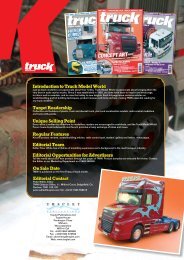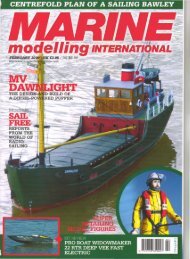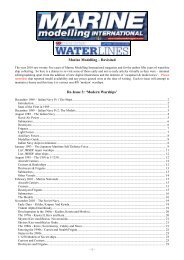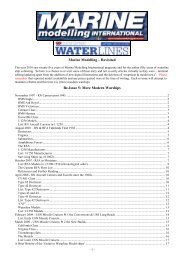Marine Modelling â Revisited Re-Issue 2: 'Foreign Warships'
Marine Modelling â Revisited Re-Issue 2: 'Foreign Warships'
Marine Modelling â Revisited Re-Issue 2: 'Foreign Warships'
You also want an ePaper? Increase the reach of your titles
YUMPU automatically turns print PDFs into web optimized ePapers that Google loves.
15" guns. Auxiliary diesels were intended to provide a wide radius of action and a speed of 24kts, whilst bringing in the<br />
main turbines gave a maximum of nearer 34 kts. Of the two models that have been produced (see list), Hansa's features the<br />
original design for the boat deck amidships and Nautilus has the final version with raised deck. The M-R scout cruisers<br />
were again designed for high speed, perhaps 35 kts, and seaworthiness with the same propulsion arrangements as O-P-Q.<br />
Armament was to have been eight 5.9" guns and stowage for 160 mines provided. The first three were laid down but little<br />
work undertaken.<br />
German naval planners also conducted feasibility studies for a series of follow on ships to the H class; very briefly these<br />
were H41 (63,000 tons, eight 16.6" guns - some design completed on this class), H42 (83,000 tons, eight 19.7" guns), H43<br />
(103,000 tons, armed as H42) and H44 (122,000 tons, eight 20" guns). Of models produced, the Hansas will probably be<br />
the easiest to find and, except for the H class which has been listed but not issued, most of the major units are present. The<br />
primary source for further study of these ships is German Warships 1815 - 1945 Volume 1 by Groner and recently<br />
published in English for the first time. The book also covers a number of cancelled aircraft carrier projects. both mercantile<br />
and warship conversions. One of the latter was the former heavy cruiser Seydlitz mentioned above as modelled by Hansa<br />
and Anker.<br />
The end of the First World War did not herald to end to warship construction and the ship building race as far as the Allied<br />
powers were concerned with Great Britain, USA and Japan all contemplating further still larger battleships. Ultimately<br />
sanity prevailed and the 1922 Washington Treaty curtailed a number of programmes. In the Pacific as early as 1916 the<br />
Imperial Japanese Navy were embarking on the so-called 8-8 Project which comprised eight battleships and eight<br />
battlecruiser intended to match or exceed American naval power in that area. Two 38,000 ton battleships of the Kaga were<br />
ordered under the 1918 programme and these ships were to be 760 feet overall, speed 26 kts with ten 16" guns in twin<br />
turrets. Both Kaga and sister ship Tosa were under construction when the Treaty came into force and the former was<br />
completed as an aircraft carrier and the latter sunk as a target. To complement the four Kongos already completed four high<br />
speed battlecruisers of the Amagi class were ordered in 1919/20. Amagi and Akagi were the first to be laid down although<br />
again the latter was finally commissioned as a carrier. Amagi was severely damaged in an earthquake in 1923 and<br />
subsequently scrapped. Perhaps the two most famous Japanese battleships are the 64,000 ton Yamato and Musashi, but less<br />
well known are the related battlecruiser class ultimately called type B65. These ships were very similar in profile to their<br />
big sisters and were first muted in 1940 as a 12.2" armed vessel with the design name B64. In 1942 the design was<br />
upgraded to incorporate a new 14.2" gun, nominally to counter the American Alaska class battlecruisers, and re-named<br />
B65. The following year the entire programme was abandoned in favour of the construction of aircraft carriers. Another<br />
Japanese project was the so-called super-Yamato with 20" guns in three twin turrets, but this 1941 vision never sailed<br />
beyond the drawing board.<br />
As early as 1936 the Italian Navy had<br />
been contemplating the need for aircraft<br />
carriers and this planning turned to<br />
substance in 1941 when the liner Roma<br />
was taken in hand. The conversion was<br />
a virtual rebuild with the hull being<br />
lengthened (to 680ft), bulges added and<br />
new machinery installed. She was<br />
nearly complete at the time of the Italian<br />
surrender in September 1943 and having<br />
been rendered unusable by allied air<br />
Projected Italian aircraft carriers<br />
attack after that date was eventually<br />
broken up in 1951. The conversion<br />
included a full flight deck, island to starboard, lifts and catapults with a planned aircraft complement of 36 RE2001 fighters<br />
some of which were to have been modified versions able to carry torpedoes. A second liner, the Augustus, was selected for<br />
a much more austere conversion which began in September 1942. Work progressed slowly, however, and twelve months<br />
later the original superstructure had been removed, but little else. In appearance the re-named Sparviero would have<br />
resembled a rather large (664ft) escort carrier but with no island, two lifts and a single hangar. The hull was scuttled by the<br />
Germans and apparently scrapped some years later. Continues next month with a look at the American, British, Russian,<br />
French and Dutch projects and the post-1945 era.<br />
NAME TYPE DATE MODEL MANUFACTURER<br />
IMPERIAL JAPANESE NAVY<br />
Tosa BB 1921 Superior 1/1200<br />
Amagi CB 1921 Superior 1/1200<br />
B65 class CB 1941 Anker 31<br />
GERMAN NAVY<br />
Mackensen CB 1919 Navis 21<br />
Ersatz Yorck CB 1920 Navis 20<br />
- 13 -







